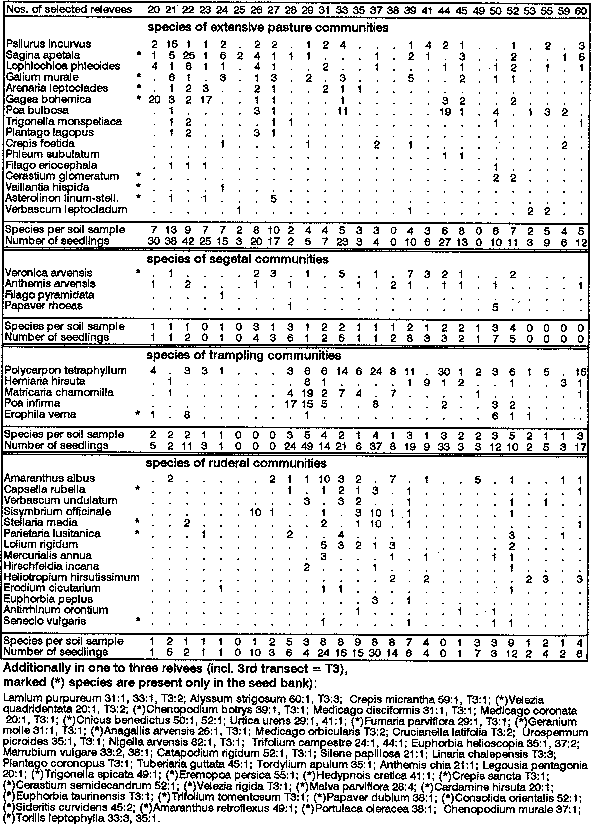| Back to 2nd page (with synopsis) |
p.
06 of 11
|
|||
|
|
||||
| Back to last page |
Next
page
|
|||
In order to complete the vegetation records, soil samples were taken from the transects 1, 2 and 3 to identify seeds of plants which had already completed their life cycle in the comparatively long dry period of 1979 (cf. Schneider & Kehl 1987).
Ten random samples (10 x 10 x 10 cm) were taken for each relevee, these were mixed and a representative soil sample of about 1kg taken. Before sampling all loose surface debris were brushed away, to ensure that only the non-transient seed bank was registered. Of the 40 soil samples collected, 6 were from the 1st transect, 20 from the 2nd, and 14 from the 3rd.
In investigations over 11/2 years, 1.714 seeds germinated, of which 1.469 seedlings could be identified. 81% of all seedlings germinated during the first vegetation period. Stand thicknesses varied widely, with extreme values from 839 seeds/m² of investigation area up to 35.720 seeds/m².
A comparison of the spectrum of species recorded in the spring and summer of 1979 with those identified in the seed bank reveals considerable differences. Of the 83 species in the seed bank, 35 (42%) were new (cf. Table 6). When attributed to the CaS groups (cf. Table 7) the largest proportion belongs to the group of the extensive pastures and Macchie clearings (47% = 39 species). This group increases at the margin of the settlement, far exceeding the species of the ruderal and segetal associations. Of particular importance are the extensive pasture species Sagina apetala, which germinated very frequently in the soil samples of the pasture area, and Gagea bohemica as a CaS of the extensive pastures, neither of which was found during the vegetation survey.
The CaS of the segetal associations and their accompanying species are very scarce inside the village. At the edges of the settlement and on the extensive pastures they are only represented sporadically. Nearly half of all seedlings were Veronica arvensis, which shows a uniform pattern of distribution through the entire 2nd transect.
The species of the trampling association also have a uniform distribution restricted to the settlement. In addition to the 8 CaS already registered in the vegetation survey, Erophila verna and Cerastium semidecandrum are also found, the former with a high population density. Attention is also drawn to the high germination numbers of Polycarpon tetraphyllum in the extensive pastures and settlement areas and to Matricaria chamomilla at the centre of the village.
In the inner settlement area the species of the ruderal association form the second largest group with 23 species (30%), but with relatively few seedlings. A characteristic of the centre of the settlement is the frequency of Amaranthus albus, Sisymbrium officinale and Lolium rigidum.
(after Schneider & Kehl 1987).
| Names
accord, to FLORA OF TURKEY (1965-85) |
Flowering
period
|
Life-form
|
CaS-group
|
| Capsella rubella |
1-12
|
A-B
|
R
|
| Erophila verna |
2-3
|
A
|
T/eP
|
| Trifolium tomentosum |
2-4
|
A
|
eP
|
| Asterolinon linum-stellatum |
2-5
|
A
|
eP
|
| Arenaria leptoclados |
2-6
|
A-B
|
eP
|
| Galium murale |
3-4
|
A
|
eP
|
| Geranium molle |
3-4
|
A
|
S
|
| Cardamine hirsuta |
3-4
|
A
|
R
|
| Gagea bohemica |
3-5
|
G
|
eP
|
| Valantia hispida |
3-5
|
A
|
eP
|
| Fumaria parviflora |
3-5
|
A
|
R
|
| Hedynois cretica |
3-5
|
A
|
eP
|
| Cerastium semidecandrum |
3-5
|
A
|
T
|
| Cerastium glomeratum |
3-6
|
A
|
eP
|
| Veronica arvensis |
3-6
|
A
|
S
|
| Eremopoa persica |
3-6
|
A
|
eP
|
| Sideritis curvidens |
3-6
|
A
|
eP
|
| Crepis sancta |
3-7
|
A
|
eP
|
| Senecio vulgaris |
3-8
|
A-B
|
R
|
| Euphorbia taurinensis |
3-8
|
A
|
sP
|
| Malva parviflora |
4
|
A
|
S/R
|
| Stellaria media |
4-6
|
A
|
R
|
| Trigonella spicata |
4-6
|
A
|
S
|
| Papaver dubium |
4-6
|
A
|
S
|
| Torilis leptophylla |
4-7
|
A
|
R
|
| Cnicus benedictus |
4-7
|
A
|
S
|
| Velezia quadridentata |
5
|
A
|
eP
|
| Parietaria lusitanica |
5-6
|
A
|
R
|
| Amaranthus retroflexus |
5-7
|
A
|
R
|
| Sagina apetala |
5-8
|
A
|
eP
|
| Velezia rigida |
5-8
|
A
|
eP
|
| Consolida orientalis |
5-8
|
A
|
S
|
| Anagalis arvensis |
5-10
|
A
|
S
|
| Chenopodium botrys |
7-10
|
A
|
R
|
| Portulaca oleracea |
7-11
|
A
|
R
|
| Key: A = annual, B = biennial, G = geophyte, R = ruderal, S = segetal, eP = extensive pastures and Macchie clearings, T = trampling areas. | |||
